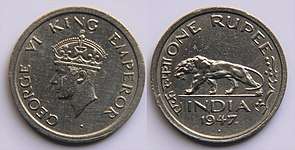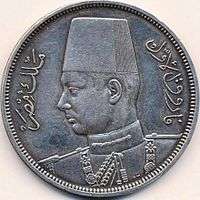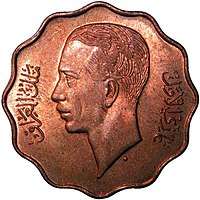Percy Metcalfe
Percy Metcalfe, CVO, RDI (14 January 1895 Wakefield – 9 October 1970 Fulham Hospital, Hammersmith, London),[1] (often spelled Metcalf without "e") was an English artist sculptor and designer. He is recognised mostly for his coin designs and his contribution to the Ashtead Pottery Collection.
Percy Metcalfe | |
|---|---|
| Born | 14 January 1895 Wakefield, England, United Kingdom |
| Died | 9 October 1970 |
| Nationality | British |
| Education | Royal College of Art, London |
Notable work | Ashtead Pottery Collection. Barnyard Collection |
Early life
He was born on 14 January 1895[2] and died on 9 October 1970 in Fulham, London.[3] Metcalfe joined the Leeds School of Art in 1910 as a general artist.[4] He moved to sculpting and designing objects as an art form at the Royal College of Art in London.[4] Here he was influenced by Francis Derwent Wood who he worked with and was mentored by.
Life as an artist
| 1947 rupee engraved by Metcalfe. | |
|---|---|
 | |
| Obverse: Crowned head of George VI with lettering "GEORGE VI KING EMPEROR". | Reverse: Bengal tiger with face value written in English, Hindi and Urdu, year and country. |
| Metcalfe designed Obverse of this coin. 159,939,000 coins minted in 1947. | |
Metcalfe designed the first coinage of the Irish Free State in 1928. The first Irish coin series consisted of eight coins. The Harp was chosen as the obverse. Metcalfe was chosen out of 6 designers as the winner of the reverse design of the Irish Free States Currency. The Horse, Salmon, Bull, Wolf-Hound, Hare, Hen, Pig and Woodcock were all on different denominations of coinage that was known as the Barnyard Collection.[5]
Metcalfe's design based on the Trinity College harp was adopted as the basis for the Great Seal of the Irish Free State in 1923 and has remained the model for all official representations of the harp emblem on seals of state, Irish coinage and the coat of arms.[6]
As a result of the war from 1914–18, the price of silver grew dramatically, until in 1920 the coins were worth more than the actual silver. Therefore, a degrade silver coinage was issued containing only fifty per cent silver. in 1935, it was George V's jubilee, and to celebrate the occasion, a crown piece containing a new design was issued. The reverse side of the coin depicts an image of St George on a horse, rearing over a dragon. Due to its modernistic design by Metcalfe it has earned little credit from collectors.[7]
In 1936 Metcalfe designed the obverse crowned effigy of Edward VIII for overseas coinage which was approved by the King, but none were minted for circulation before Edward's abdication in December of that year.[8]
Metcalfe was immediately assigned to produce a similar crowned portrait of King George VI for overseas use. This image was also used as part of the George Cross design in 1940. The George Cross is second in the order of wear in the United Kingdom honours system and is the highest gallantry award for civilians, as well as for members of the armed forces in actions for which purely military honours would not normally be granted. It also features the flag of Malta in recognition of the island's bravery during the Siege of Malta in World War II. Metcalfe also designed the Great Seal of the Realm. He produced designs for coinage of several countries including Ireland and Australia. He created a portrait of King George V which was used as the obverse for coins of Australia, Canada, Fiji, Mauritius, New Zealand and Southern Rhodesia.
To commemorate the extraordinary visit that George VI and Queen Elizabeth set out on to North America in 1939, three series of medallions were designed for the Royal Canadian Mint. The reverse side of the coins contained a joint profile of George VI and Queen Elizabeth, which was designed by Percy Metcalfe. This design was also used on the British Coronation Medal of 1937.
Metcalfe created a British Jubilee crown piece, which was exhibited in the Leeds College of Art in November 1946[9]
Other work
In the 1930s Metcalfe designed car mascots.
He produced many designs for Ashtead Pottery[10] between 1923 and 1936.[11]
One of his noted sculptural works is the bronze war memorial in Durban, South Africa.
Posthumous use of designs
In 2010, the Central Bank of Ireland issued euro coins featuring Metcalfe's Irish coin designs, specifically the salmon and horse design,[12] with slight modifications to represent the "new generation." This was the first time his work was presented on the euro currency.[13]
This selection of coins is a second series of three limited edition annual mint coin sets issued by the Central Bank in honour of animals that have previously appeared on Irish coinage. The first set featured the horse while the third in the series will pay tribute to the hound. Each set in the series is followed by a silver proof €15 coin. Along with the horse and the hound, the series of coins pays tribute to three iconic animals which have important historical connections with Ireland.
Works
Barnyard Collection. Irish Free State Currency.
| Name | Numeral | Reverse Design | Image |
|---|---|---|---|
| Farthing | ¼d | Woodcock | |
| Halfpenny | ½d | Pig and Piglets | |
| Penny | d | Hen and Chicks | |
| Threepence | 3d | Hare | [14] |
| Sixpence | 6d | Wolfhound | |
| Shilling | 1s | Bull | |
| Florin | 2s | Salmon | |
| Half Crown | 2s6d | Horse |
Other Coin Designs
| Name | Location | Comments | Image |
|---|---|---|---|
| Barnyard Collection | Irish Free State | Percy Metcalfe is known for designing the first set of Irish Free State coinage released in 1926. He won a competition over a few other artists. This coinage has barnyard animals on each coin and is called the 'Barnyard Set'. | The coin set is above this table. |
| Egypt Coinage | Egypt | Percy Metcalfe was assigned by the Royal Mint to design a coin for the King Farouk, his initials 'PM' can be seen in the bottom middle of the coin. |
|
| Iraq King Coin Set | Iraq | Metcalfe created coin effigies of two kings of Iraq. His portrait of King Faisal I first appeared on the coins of Iraq in 1931, whilst his portrait of King Ghazi was first seen on coins in 1936. This is a coin of King Ghazi. |
|
References
- Biographical details of Percy Metcalfe in: Mapping the Practice and Profession of Sculpture in Britain and Ireland 1851–1951, University of Glasgow History of Art and HATII, online database 2011. Retrieved 20 April 2014.
- http://www.freebmd.org.uk/cgi/information.pl?r=92792988:1646&d=bmd_1445847588
- http://www.freebmd.org.uk/cgi/information.pl?r=241504354:8423&d=bmd_1445847588
- "Dictionary of Irish Biography – Cambridge University Press". dib.cambridge.org. Retrieved 6 October 2017.
- "1928 coins". Flickr – Photo Sharing!. Retrieved 18 November 2015.
- "Tuning the harp to suit a changing Ireland". The Irish Times. Retrieved 23 November 2015.
- "Coin Collecting – English Coins IV". oldandsold.com. Retrieved 6 October 2017.
- Dyer, G.P. (1973) The Proposed Coinage of Edward VIII, HMSO.
- http://collections.museumvictoria.com.au/articles/2358
- "Ashtead Potters Limited". ashteadpottery.com. Retrieved 18 November 2015.
- Ashtead Potters – Pottery Figures Archived 13 February 2008 at the Wayback Machine
- "Central Bank of Ireland to Issue "Barnyard" Euro Coin Series | Coin Update". news.coinupdate.com. Retrieved 18 November 2015.
- Office, Dublin Mint, Limited Edition Solid Sterling Silver Coin honouring Percy Metcalfe's original equestrian design, archived from the original on 15 October 2013, retrieved 15 October 2013
- "World Coin Gallery".
External links
- The George Cross
- Percy Metcalfe in: World of coins
- http://worldcoingallery.com/countries/Ireland_all.php
- http://www.irishcoinage.com/MODCAT.HTM#modfln

